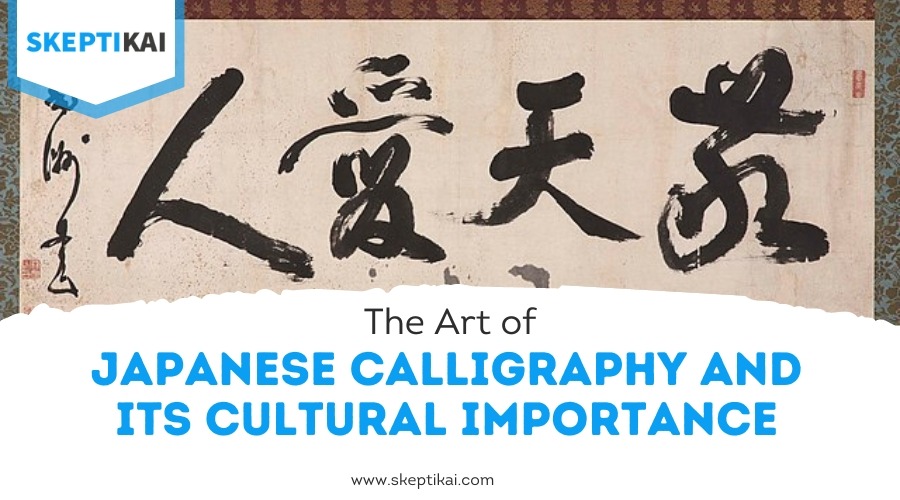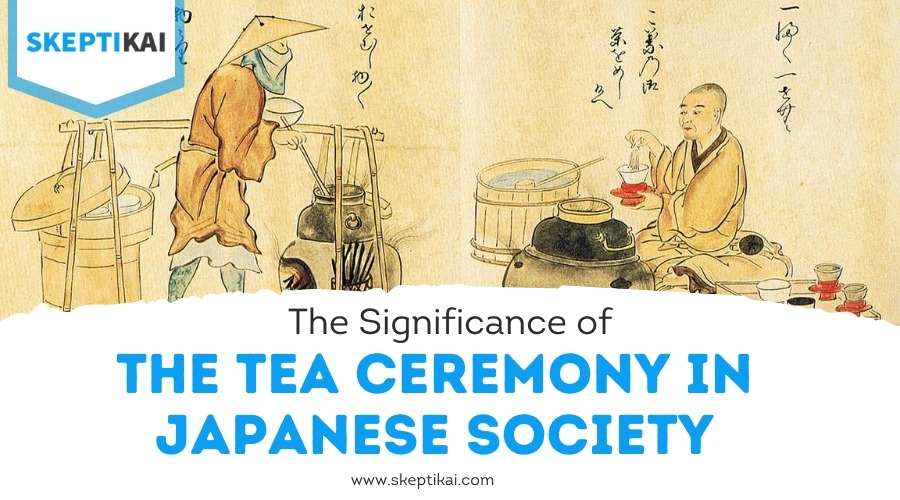How Has Japanese Culture Changed Over Time?

Japanese culture has evolved remarkably over time. Initially, ancient traditions focused on Shinto rituals that promoted harmony with nature. The influence of Chinese culture began shaping language, art, and philosophy. During the Samurai Period, values like honor and loyalty permeated society. The Meiji Period ushered in Westernization, changing clothing, education, and industry. After WWII, Japan experienced shifts in gender roles and global economic influence. Pop culture boomed with anime and J-pop, enchanting audiences worldwide. Technology and globalization continue to blend tradition with modernity, creating a unique cultural identity. Investigate further to see how these transformations interlink.
Ancient Traditions and Beliefs
Ancient Japanese culture is steeped in traditions and beliefs that have shaped its identity for centuries. You'll find that Shinto rituals play a central role, emphasizing harmony with nature and the spirits residing in all things. These spiritual beliefs are intricately woven into the fabric of everyday life, influencing diverse folk practices and seasonal festivals. For instance, during these festivals, you might participate in events that honor deities and ancestors, showcasing a deep respect for the past. Shinto's influence is also evident in Japanese calligraphy, which reflects the aesthetic and spiritual values of the religion. Traditional arts like calligraphy, tea ceremonies, and ikebana reflect Japan's rich cultural tapestry. Engaging in these arts not only connects you with history but also with the spiritual essence of creation. The importance of family structures is evident as well, where ancestral worship is a common practice. You're encouraged to honor your ancestors through rituals and offerings, reinforcing familial ties across generations. Historical narratives passed down through generations offer insight into Japan's storied past, helping you understand the evolution of these cultural elements. By embracing these traditions, you gain a deeper appreciation for the values and beliefs that have endured through time, providing a sense of continuity and identity.
Influence of Chinese Culture

You'll quickly notice how Chinese culture has greatly influenced Japan throughout history. This influence is evident in numerous aspects, from language to art. When you investigate the domains of calligraphy art, you'll see that Japanese calligraphy, known as "shodō," has roots in Chinese calligraphy. The styles, techniques, and even the tools used in Japanese calligraphy were initially adopted from Chinese traditions. As you practice or observe shodō, you're engaging with an art form that beautifully blends Chinese and Japanese elements. Furthermore, Japanese education emphasizes traditional values like harmony and perseverance, which have historical ties to Confucian ideals. Another area where Chinese culture left its mark is in historical texts. During the Asuka and Nara periods, many Japanese scholars traveled to China, bringing back Chinese philosophy, literature, and government concepts. These influences are evident in Japan's earliest historical texts, such as the "Nihon Shoki" and "Kojiki," which were compiled using Chinese characters. When you investigate these texts, you see how they incorporate Chinese ideas, yet they also highlight Japan's unique interpretations and adaptations.
The Impact of the Samurai Era

Marked by its distinct warrior class, the Samurai Period profoundly shaped Japan's social, political, and cultural landscape. You can't overlook the lasting influence of the samurai, whose way of life revolved around the bushido code, a set of principles emphasizing honor, loyalty, and discipline. These values weren't just confined to the samurai themselves; they permeated Japanese society, influencing the behavior and beliefs of people at all levels. The samurai philosophy emphasized not only martial prowess but also cultural and intellectual pursuits, encouraging a balanced life of both physical and mental discipline.
Politically, the samurai played essential roles as both warriors and administrators, serving their lords and shaping governance structures that prioritized loyalty and duty. The hierarchical system they upheld became a blueprint for societal organization, establishing norms that persisted long after the samurai's official role diminished.
Culturally, the samurai's influence extended to arts such as calligraphy, poetry, and tea ceremonies, which were seen as extensions of their disciplined and refined lifestyle. By adhering to the bushido code, the samurai instilled a deep-rooted sense of identity and purpose, elements that continue to resonate in Japan even today.
Westernization During Meiji Era
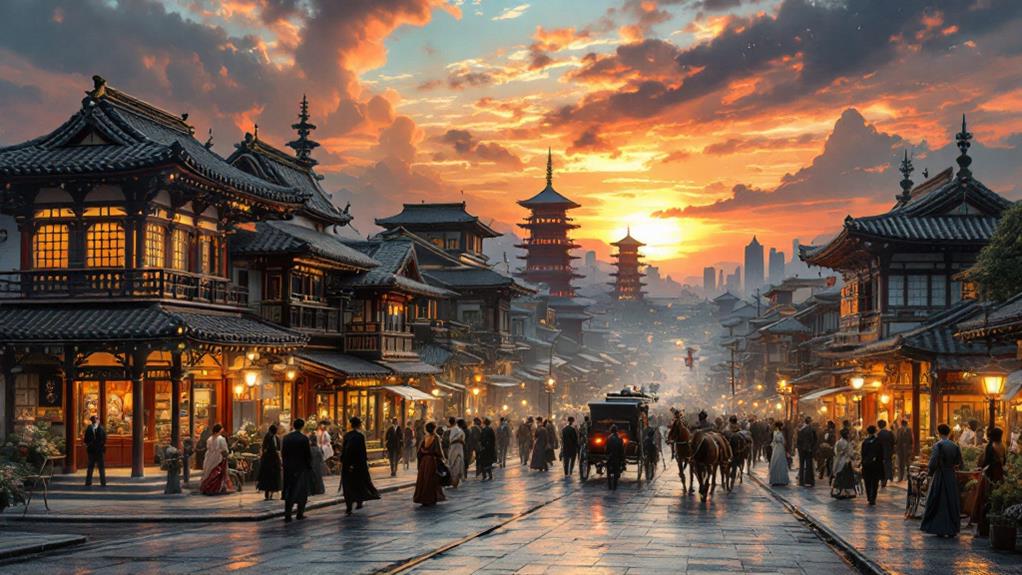
As Japan opened its doors to the world during the Meiji Period, it initiated a transformative expedition of Westernization that reshaped its society. The Meiji reforms sought to modernize Japan by embracing Western ideas and technologies. You could see this transformation in the adoption of Western fashion, as traditional kimonos were increasingly replaced by suits and dresses, symbolizing a shift in cultural identity.
Educational changes played a vital role in this Westernization. The government introduced Western-style education systems, emphasizing science and technology. This modern approach aimed to cultivate a generation capable of driving Japan's industrial advancements. You might notice how these reforms rapidly accelerated Japan's shift into an industrial powerhouse, as new railways and factories sprouted across the country.
Cultural exchanges with Western nations also flourished during this period. Japan sent students abroad to learn foreign technologies and governance systems, while Western experts were invited to impart their knowledge. These exchanges fueled Japan's imperial ambitions, as the nation sought to emulate Western powers by expanding its influence. You'd find that this phase of rapid change set the stage for Japan's emergence as a modern global power, forever altering its cultural landscape.
Post-WWII Cultural Shifts
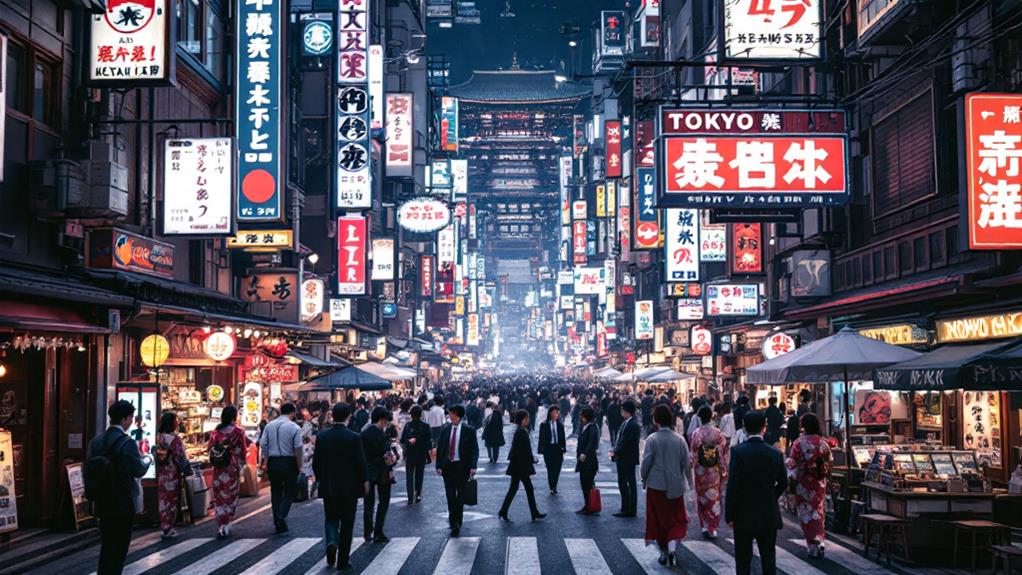
In the aftermath of World War II, Japan underwent significant cultural shifts that redefined its national identity. You'll notice how gender roles transformed as women began entering the workforce in unprecedented numbers, challenging traditional expectations. This participation contributed to economic changes, as Japan experienced rapid industrial growth, leading to the nation becoming a global economic powerhouse. These economic shifts weren't just about money—they affected societal norms and family dynamics, altering how people lived and interacted.
Meanwhile, a lively youth culture emerged, influenced by Western ideals but distinctly Japanese in its expression. Young people started questioning conventional values, embracing new fashions, music, and lifestyles that reflected their desire for change and freedom. This change wasn't merely superficial; it represented a deeper transformation in how younger generations viewed the world and their place within it.
Artistic expression also evolved, responding to the societal upheaval and new influences. Artists experimented with styles and mediums, producing works that captured the spirit of a nation in flux. Regardless of whether through literature, film, or visual arts, these creative endeavors reflected and shaped the cultural identity of post-war Japan, leaving a lasting impact on the global stage.
Rise of Pop Culture
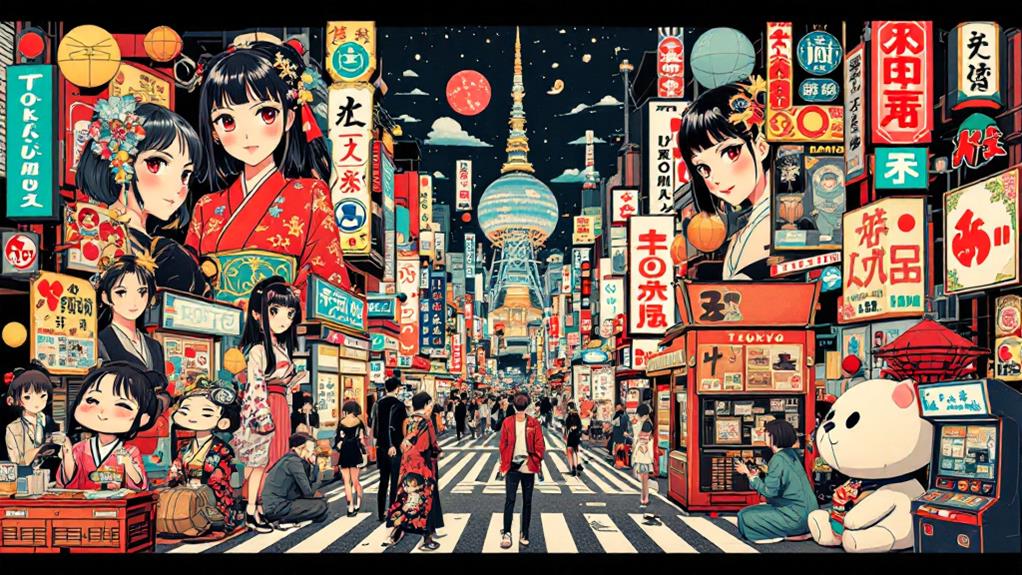
Through the latter half of the 20th century, Japan saw the dynamic rise of pop culture, a phenomenon that captured the imaginations of both domestic and international audiences. At the forefront of this cultural wave was the anime evolution, transforming animated storytelling into a global powerhouse. You'd notice how series like "Dragon Ball" and "Sailor Moon" transcended borders, creating passionate fanbases worldwide. Alongside anime, the J pop phenomena exploded, with catchy tunes and choreographed performances from idol groups enchanting the hearts of fans.
Fashion trends in Japan also underwent significant changes, influenced by the lively street style of Harajuku. This area became a hub for unique and eclectic fashion, reflecting the bold creativity of Japanese youth. As you explore deeper into pop culture, you can't overlook the otaku culture, where devoted fans engage themselves in anime and manga, creating communities bonded by shared passions.
Media influence played a key role in spreading these cultural elements, while virtual idols like Hatsune Miku expanded the boundaries of pop culture further. Together, these aspects of pop culture not only defined a period but also left a lasting impression on global culture.
Technology and Modernization
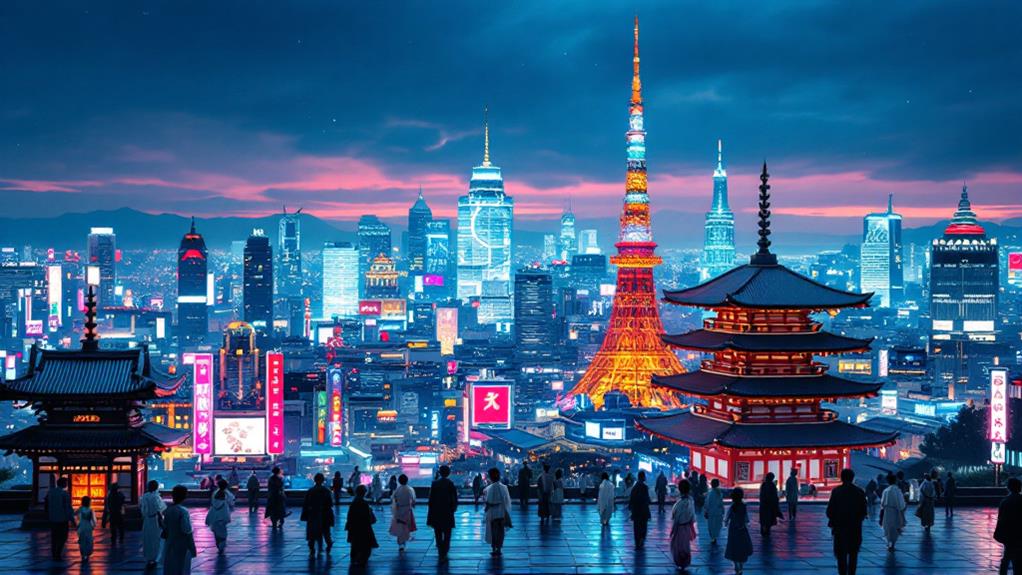
Pop culture's lively pulse set the stage for Japan's technological and modern advancements. You've probably noticed how Japan's futuristic edge has become synonymous with its dynamic culture. This is no surprise, given its seamless robotics integration in everyday life. From automated sushi restaurants to humanoid robots assisting in healthcare, Japan's technological prowess is evident everywhere. You're witnessing a society where technology isn't just an add-on but a core part of daily life.
Digital communication has also fundamentally reshaped how people in Japan connect. With the rise of smartphones and high-speed internet, your interactions are no longer bound by physical presence. You're likely using apps like LINE to chat with friends or engage in virtual reality experiences that blur the line between digital and real. These tools have made communication faster and more efficient, keeping you in touch with the world in real-time.
Together, these advancements in robotics and digital communication have propelled Japan into a contemporary period that marries tradition with cutting-edge technology. You're part of a culture that welcomes change, using technology to improve life while maintaining its unique cultural essence.
Globalization and Cultural Identity
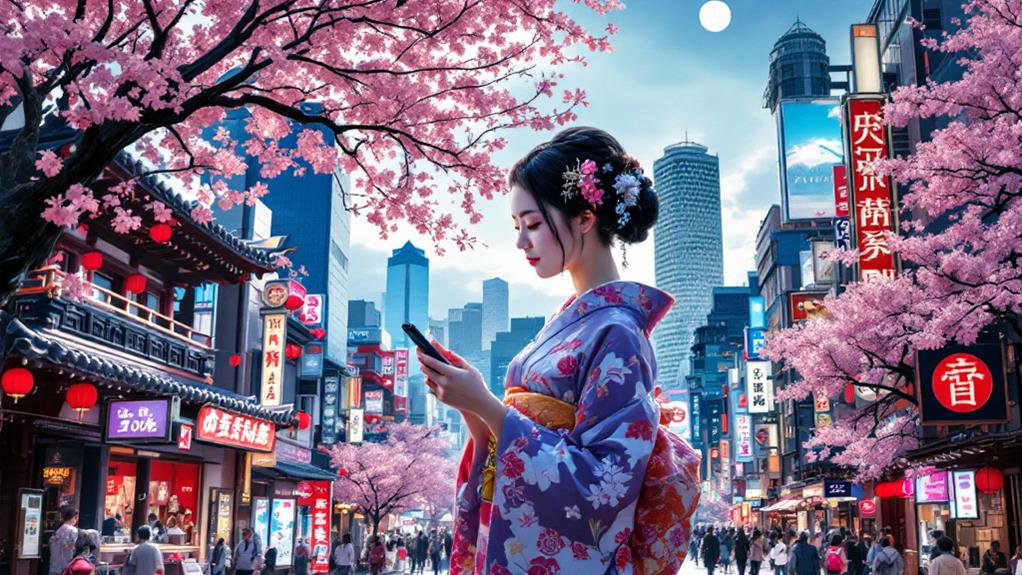
As you wander through lively Tokyo streets or investigate the serene temples of Kyoto, you can see how globalization has woven its threads into Japan's cultural tapestry. The dynamic mix of Western and traditional elements highlights a cultural fusion unique to Japan. Cafes serving matcha lattes sit next to century-old sushi bars, while anime characters adorn global brand stores. This blend doesn't just reflect a mere adaptation but also a profound identity evolution, showcasing how Japan welcomes the new while honoring the old.
You'll notice how Japan's language too has absorbed foreign words, reflecting the global influences shaping everyday life. Globalization has prompted a dialogue between Japan and the world, transforming how cultural identity is perceived and lived. Regardless of whether it's through fashion, music, or technology, the fusion is evident and celebrated. Yet, this evolution also raises questions about preserving traditional values amidst rapid change.

